Advertisement
A sailor turns his dream of energy-independent long-distance cruising into reality with tenacity, creativity — and many helping hands.
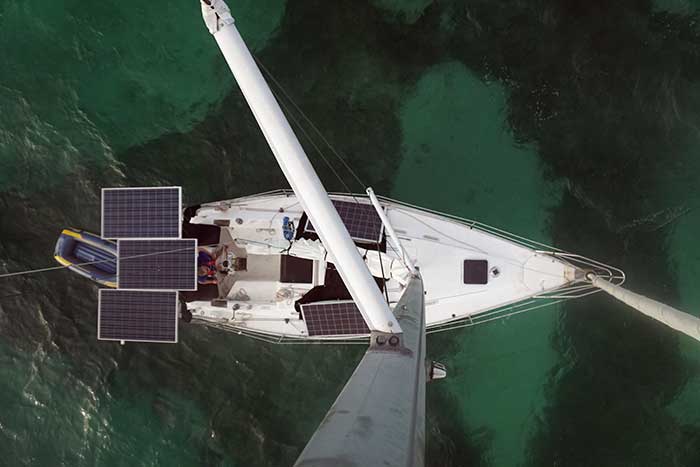
Photo: Vittoria Energy Expedition
All boating seasons are not created equal. The best have more highs than lows, minimal repairs, and more time on the water. The worst are money pits spent fixing, cursing, and praying for one decent outing. Then, there are the life-changing seasons somewhere in between. For the past two years, I've lived that season from the helm of a solar-electric boat.
As a lifelong powerboater, I've always loved the speed, smell, and sound of a roaring engine. But the first time I sailed, something strange happened. This feeling of infinity came over me as I imagined the distant lands this lumbering craft could take me. I pursued that feeling, becoming a sailor, instructor, then sailboat owner.
Fixing, tinkering, and sailing became my steady hobby, but my passion remained the adventure. This led to open-water sailing on Chesapeake Bay. For a week, two friends and I explored the bay aboard my 25-foot Catalina, visiting uninhabited beaches and quaint towns of Maryland's Eastern Shore. The highlight was entering the Atlantic Ocean — just to get a taste of true big water. This was the beginning of infinity to us, our gateway to the world. Looking out at the endless sea, none of us had ever felt such a pull to quit our jobs and chase the horizon.
Returning to the bay after this glimpse of the possibilities, we found our fuel low and our batteries nearly drained. This mini adventure of only 150 miles with inconsistent wind had quickly depleted our energy reserves. At this sobering realization, we put in for the night, but I couldn't shake the defeat.
Shopping List
- 8 x 260Ah 12V Group 8D AGM batteries from Apex Battery
- Midnite Solar Classic 250 MPPT solar charge controller
- Thunderstruck 14kw 48V DC motor + motor controller + motor mount
- Madjax 30A DC power converter (to drop the 48V current to 12V)
- 5 x polycrystalline panels ranging from 230 to 260 watts (from Canadian Solar and Winaico)
- Victron BMV 700 battery monitor + Bluetooth dongle
- 2000W 48V pure sine inverter charger by AIMS Power
The Big Idea
Our experience got me thinking back to a trip I'd once taken across rural Namibia in Africa. Sprinkled through this land are far-flung ranches living off the grid, disconnected from central power plants. While many homes run on huge diesel generators, some have adopted solar systems with battery storage. Instead of driving three hours each way to refill a tanker truck of diesel in the closest town, a rancher explained, solar and battery systems could be installed once and run for many years with minimal maintenance. If solar made sense in an isolated place like that, surely it could work on a boat.
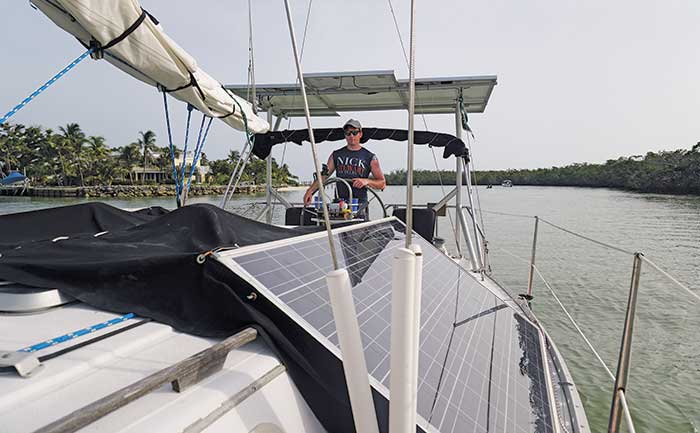
The author at the helm and cruising his unique boat under clean power off Marathon, Florida. (Photo: Vittoria Energy Expedition)
We were already using a small solar panel onboard to charge cellphones, but that was it. Inspired, our crew embraced the idea of building an “infinity boat” powered only by wind and sun. That fall, first mate Chad and I chased the dream and began our research. While neither of us were strangers to a good home-improvement project, we weren't well versed in electrical systems or silicon crystals. Enter the internet. After basic sleuthing, we contacted fellow tinkerers who showed us their own solar projects. With their encouragement and a dogging fear of failure, we set out to purchase a boat to customize.
Man With A Plan
We envisioned a 35-foot sailboat with plenty of room for solar panels, for about $10,000 — a tall order. After inspecting many used boats, we found a sturdy 31-foot 1985 Hunter priced to sell and needing interior work. I'd scrimped for months to stockpile $4,000 toward this boondoggle — well short of my original goal — but I was determined to make it work. Intrigued by our infinity boat idea, her owner accepted $4,000 and the journey began.
We named her Vittoria after the first ship to successfully circumnavigate the globe as the sole survivor of the Portuguese explorer Ferdinand Magellan's 16th-century expedition. Our team would turn her into an exclusively electric vessel to explore renewable energy projects along the Atlantic coast, across the Florida Strait to Cuba, and into more distant waters.
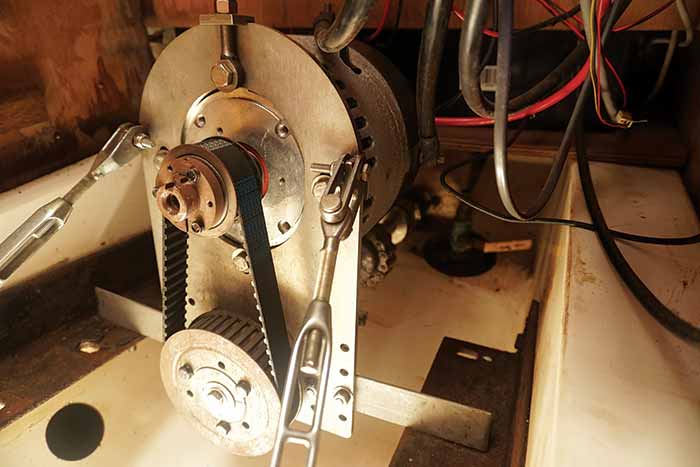
The mounted 35-pound DC motor that replaced the original 650-pound diesel. (Photo: Vittoria Energy Expedition)
Vittoria was initially powered by a 650-pound diesel and an 18-gallon fuel tank. Our goal was to achieve complete energy independence for propulsion and onboard electronics by going all-electric — replacing the diesel engine and creating a self-sufficient system to generate, store, and convert electricity into motion.
Friends Indeed
Over the next five months, we transformed this 30-year-old Vittoria into something vibrant and unique. Our crew — in our 20s and 30s — work consuming full-time jobs in Washington, D.C., so weekends were the only opportunity to hammer, saw, and drill away. We started with simple cleaning, minor repairs, then sanding and painting the rusty-keeled hull.
Our newest team recruit, Andrew, a blossoming solar blogger, secured a donation of five solar panels from our first official sponsor, a local installation company named Solar Solution. We found another sponsor in the family-owned Frager's Hardware, whose staff took an interest in our renewable-energy approach and lent us tools and advice. As the time drew closer for installing the solar and other energy equipment, our friend and sailing mentor Casey invited us to finish the boat at his family marina in Maryland, offering tools, a workshop, and sweat equity.
Shoestring Creativity
We'd established the Vittoria Project as an educational nonprofit with a mission to share the story of our renewable-energy boat. To realize this vision, we hosted a fundraiser with raffle prizes and bar donated by supporters like Patagonia, Mount Gay Rum, Lagunitas beer, Marriott Hotels, DC Sail, and others. These sponsors and 250 party attendees helped us raise $8,000 toward the build. In boating terms, that's not a lot of money. Just an electric motor and small battery system could've busted our budget. We also needed wiring for the solar panels, a solar-charge controller, AC/DC inverter, battery monitor, and other components. Ours would be a poor man's infinity boat, so we had to get creative.
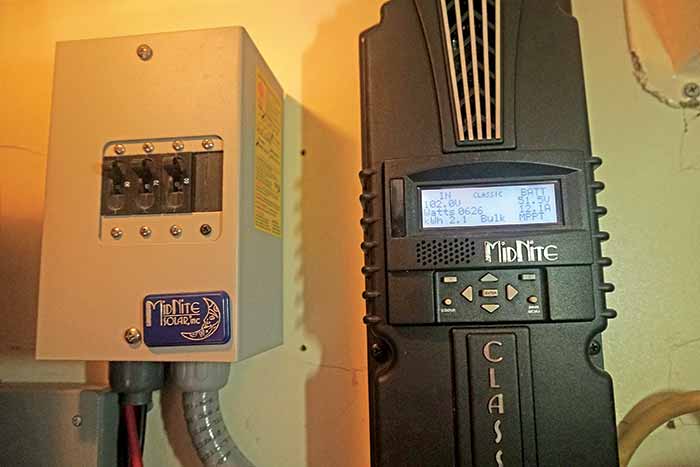
The MidNite Solar charge controller. (Photo: Vittoria Energy Expedition)
For $2,200 we purchased an electric-motor package designed for a go-kart, including motor, mount, and controller, with power equivalent to our 16-hp diesel engine. For another $3,300 we picked up eight 260Ah AGM batteries wired together as 48 volts. Our solar-charge controller cost $700, and wiring was an extra $100. The five polycrystalline solar panels were donated, but their combined value was around $1,000. We managed to assemble the components of this core system for $7,300 in total. To improve functionality, we added a Bluetooth battery monitor for $240 and an inverter/charger for $630 to activate our AC outlets on battery power. Because our motor required us to string the eight batteries together as a 48V system, we also needed to install a $130 voltage reducer to step down power for the boat's existing 12V outlets and equipment, such as lights and VHF radio.
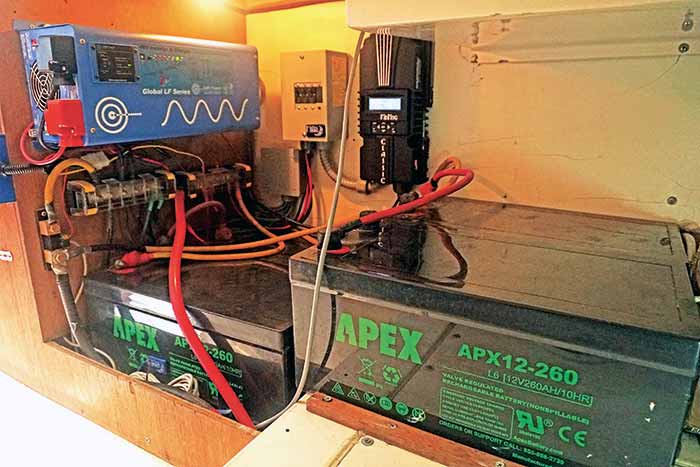
This is the heart of Vittoria's energy-storage system. Components here include the solar charge controller, Apex AGM batteries, and a pure sine inverter charger. (Photo: Vittoria Energy Expedition)
Now we had to put it together. We started with the panels, sketching out possible mounting options. They were big panels designed for the roof of a house, and we were trying to put them on a boat with a lot of moving parts. Finding a way to secure the panels without them flying off or interfering with the sails, deck, or helm was a challenge. We brainstormed for weeks and finally agreed to slope two panels off the cabin and mount the three smaller ones on an aluminum-pipe canopy over the helm. The canopy work alone took five weeks, two different welders, a truck of aircraft-grade aluminum, and our entire core team to affix the metal behemoth.
After installing solar panels, we began mounting the motor and batteries. We hoisted out the 650-pound Yanmar engine and replaced it with a 35-pound 48-volt electric motor and eight batteries, totaling 1,300 pounds. We then connected it all, snaking wire the size of a garden hose from battery to battery with the help of our friend and technical adviser Pete. On balance, the added weight was modest as we no longer needed the 18 gallons of diesel.
Sea-Trial Travails
Three months into the build, our solar panels, motor, and batteries were in place. It was time for a sea trial when Pete and I finished wiring the helm at 3 a.m. under a moonlit sky. I was biting my nails as we turned it on and throttled forward. Our boat lurched — backward! After one small exchange in the cables, we fixed the problem and motored off into the night for a short cruise — with only the sound of waves slapping the hull.
Late nights and constant discovery were the norm throughout the project. We learned the difference between wiring in-series versus parallel, used laser-guided bench saws, applied once-forgotten algebra for equipment designs, fabricated metal works, and got a crash course in battery chemistry. From theory to application, it was rewarding to watch our idea become reality.
Determined to debut Vittoria at a popular regatta in D.C., I shoved off the following week, solo-sailing 100 miles overnight and through the next day north up the Potomac River.
Over the fall, our team hosted hundreds of people for onboard classrooms and dockside fundraising parties. Student groups even took her for a spin beneath the shimmering capital skyline. For two months, Vittoria graced D.C.'s waters as the crew made final preparations for a journey down the Atlantic coast where we'd explore local renewable-energy projects to film a series on the personal empowerment of solar, wind, and battery systems. With events, videos, and articles, our goal is to highlight how modern solar and other renewables are providing practical energy solutions to everyday people.
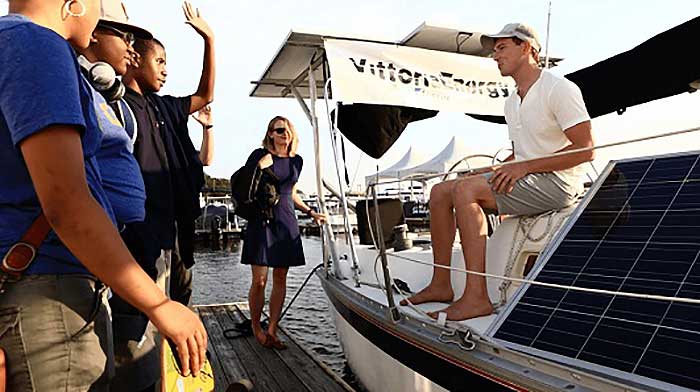
The author explains his story and mission at one of the roving community classrooms, this one at an after-school program in Washington, D.C. (Photo: Vittoria Energy Expedition)
Infinity And Beyond
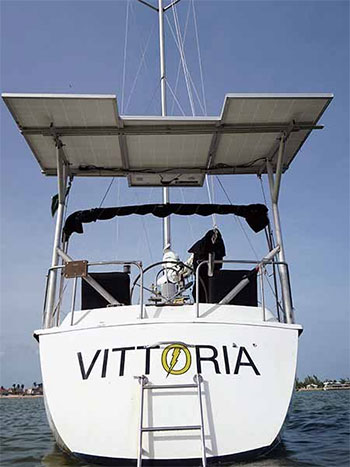
The author describes his inspiring Vittoria Energy Expedition as
a travel-inspired nonprofit organization sharing the stories of
innovative renewable energy developments. He and his crew
plan to continue spreading the word on energy independence
and self-reliance through expeditions across America and
around the world.
In late October, the winds shifted to northerly and we chose Veterans Day for our departure. On a breezy Friday afternoon, Vittoria began her southern voyage down the Potomac en route to the Atlantic. We made record time sailing overnight, back to Tall Timbers Marina for a lively goodbye at their annual Oyster Fest. Over live bluegrass music and local brews, we listened to advice about the adventure ahead and filmed energy discussions with locals. This would be the first of many stops, but the last in familiar territory. The next evening, our team continued south, full of hope and uncertainty, with no plans to return.
Over the following months, we sailed Vittoria to stops along the Atlantic coast, turning heads and making new friends. At each stop, we visited renewable-energy projects to document the personal impacts of these technologies — rural homeowners powering their lives with solar, coastal communities running Tesla battery farms, and salty boaters with independent streaks who were thrilled by our all-electric boat.
Most of us work full-time desk jobs at various organizations in D.C., so we chase the adventure using precious vacation time and long weekends, slowly making our way down the Atlantic coast. After each leg, we park Vittoria at a new port of call, then fly back to the office. Juggling a small team with conflicting schedules, we've recruited more than a dozen friends and friends of friends to help out. Challenging the endurance of each new crew, we sail 24-hour segments with revolving shifts for days at a time — quite the logistical marvel.
Advertisement
We've sailed through sleepless nights into rose-colored dawns and braved sudden squalls along Blackbeard's storied Outer Banks. Vittoria has glided with dolphins near Charleston and waited patiently for bridges in the Intracoastal Waterway. She's sailed blue water for as far as the eye can see, and between Miami skyscrapers in crowded canals. Now, she rests in the Florida Keys with ambitions set south and beyond.
Boating, like much of life, is about the high highs and the low lows. In this setting, a miserable, cold, wet, lonely night becomes a stunning sunrise, a chance sea turtle encounter, a perfect sky filled with more shooting stars than most people see in a lifetime. One member of our crew, Ryan, described it as "Type 1" and "Type 2" fun. Type 1 is the kind you have in the moment, like riding a roller coaster. With Type 2, you're absolutely miserable in the moment but look back later and cherish that memory. He explained this on a stormy night, just after heaving over the side, which qualifies as Type 2 fun.
The Vittoria energy expedition has been full of both types of fun, from the spark of an idea to the end of our first 1,500-mile voyage. As our course looks toward the unknown, one thing is certain: This adventure has changed our lives and inspired imagination, as the best voyages can sometimes do.
Nathan's 6 Takeaways After 1,500 Miles
1. We've motored about 70 percent of the time (about 1,050 miles). Our old diesel would operate at about 0.5 gallons per hour at 5 mph, or 10 miles per gallon x $4/gallon (approx.) = 105 gallons over the 1,050 miles = $420 savings. Shore power service is $30/month x 2 years = $720 savings. Our total savings so far is $1,140, plus savings from the diesel we would have used to regularly run the engine to keep the batteries topped off. The cost of our basic power regeneration and storage system was $5,100. In addition, the motor, mount, and controller were $2,200.
Over time, at this rate, the system will pay for itself. The real attraction is that we can be self-sustaining. After all, you can't refuel in the middle of the ocean!
2. Buying non-marine-specific solar and other electrical equipment saved a bundle and hasn't impacted performance. [BoatUS recommends using marine-grade products when possible.]
3. Electric motors are power-hungry. Getting 3.5 knots from our motor on flat water consumes about the same energy as running six full-size refrigerators — at once! You need a lot of batteries and recharge capacity to sustain a modest cruise for long distances.
4. Cost for AGMs isn't likely to change in the near future. But using properly installed Lithium-ion batteries instead could improve performance. They're only one-third the weight of AGMs for the same energy. So our 1,300 pounds of batteries could be just 430 pounds with Lithium. The cost, however, isn't currently competitive — about $209/kWh on average. The good news? Prices for Lithium batteries have dropped 50 percent since 2010, and conservative estimates suggest another 50 percent drop by 2025, reaching $100/kWh.
5. Running Vittoria's motor at a modest 3.5 knot rate under ambient conditions, we get about 60 nautical miles on one charge without any solar regeneration.
6. It takes a village. Without the support of family, friends, mentors, and sponsors, we would still be sitting on the hard!
